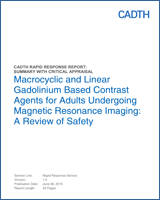| Gutierrez, 2015a6 |
|---|
|
|
Gadobutrol was found to have a similar safety profile to other MRI contrast agents The findings were consistent with previous studies, with respect to safety
|
| Gutierrez, 2015b5 |
|---|
67 patients in the study (n = 343) reported at least one adverse event, 14 of which were gadobutrol-related but not serious One patient reported a serious adverse event that was determined to be unrelated to gadobutrol No deaths or discontinuations were reported No significant changes in vital signs, clinical laboratory values or hematological parameters were reported
|
Gadobutrol has a very good safety profile The findings are consistent with previous studies, with respect to safety
|
| Kuwatsuru, 20154 |
|---|
13 patients that received gadobutrol-enhanced MRI (n = 178) experienced 12 mild treatment-emergent adverse events
Seven patients experienced seven drug-related treatment-emergent adverse events One patient experienced one severe treatmentemergent adverse event, which resolved after 15 minutes
16 patients that received gadopentetate dimeglumineenhanced MRI (n = 185) experienced 13 mild treatmentemergent adverse events
When compared to the baseline values, there were no significant changes in clinical laboratory values, vital signs or physical examinations up to 24 hours after injection No serious adverse events, deaths or discontinuations were reported for gadobutrol or gadopentetate dimeglumine
|
|
| Liang, 201218 |
|---|
Six out of 146 patients included in the safety analysis reported mild adverse events; one adverse event was determined to be related to the treatment Four adverse events were experienced by two patients in the gadobutrol group; four adverse events were experienced by four patients in the gadopentetate dimeglumine group
|
|
| Naito, 20177 |
|---|
Patients who received gadodiamide or gadopentetate dimeglumine did not experience contrast-induced nephropathy (CIN) Gadodiamide significantly increased serum cystatin-C levels from 0.74 to 0.79 (p = 0.028) In patients with stage 1 CKD who received gadodiamide, serum cystatin-C levels significantly increased from 0.69 to 0.72 (p = 0.047) In patients with stage 2 CKD who received gadodiamide, serum-creatinine levels significantly increased from 0.74 to 0.77 (p = 0.049); CCr levels significantly decreased from 80.5 to 78.5 (p = 0.039); and eGFR levels significantly decreased from 79.3 to 77.1 (p = 0.039)
|
Small amounts of gadolinium are safe for patients with normal or mildly-diminished renal failure Administration of gadopentetate dimeglumine has no effect on renal function Gadodiamide has slight nephrotoxicity in patients with stage 1 or 2 CKD, however, this finding is not clinically important
|
| Semelka, 201320 |
|---|
No patients experienced mild (specifically emesis or hives), moderate or severe adverse events All images were rated as having “good” overall enhancement adequacy (from “poor”, “fair”, or “good”)
|
|
| Tanaka, 201621 |
|---|
19 patients (out of n = 223) reported at least one treatmentemergent adverse event, of which 6 were gadobutrolrelated The most common gadobutrol-related treatment-emergent adverse event was hot flush, experienced by 2 patients No severe adverse events or deaths were reported
|
|
| Zech, 201919 |
|---|
9 patients in each group experienced at least 1 adverse event (n = 146 received gadoxetate disodium, n = 149 received gadobenate dimeglumine) 9 of 12 adverse events in the gadoxetate disodium group were probably related to the contrast administration 7 of 14 adverse events in the gadobenate dimeglumine group were possibly or probably related to the contrast administration
|
|
